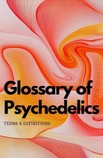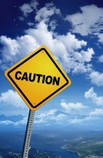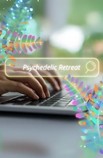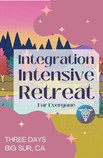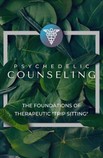Unlocking the World of Psychedelics
So, you’ve heard the buzz about psychedelics, and perhaps you’re curious to try them yourself. Maybe you’ve caught wind of the research on psilocybin for depression or anxiety, or you’ve read news reports about localities across the country decriminalizing plant medicines. Perhaps you’ve been intrigued by word on the street about friends going to ayahuasca ceremonies or retreats in the jungle. Or, you could simply be curious to expand your consciousness and traverse the realms beyond mundane reality. Whatever brought you here—whether you’re looking to heal, have fun, garner a spiritual connection, or just explore what psychedelics have to offer—welcome to the threshold of a potentially life-changing journey.
“As you navigate this new terrain, cultivate a healthy respect for these powerful substances. Approach them with intention, care, and a willingness to do the inner work.”
— Madison Margolin
But where do you start? The world of psychedelics can seem vast and intimidating, what with the different compounds out there, how to take them, how to prepare, and how to ensure that you have a safe—and hopefully beneficial—experience. This guide can help you on your psychedelic path.
What are psychedelics?
Psychedelics are a class of psychoactive substances that alter perception, mood, and cognitive processes. These substances, which include compounds like LSD, psilocybin (found in magic mushrooms), and DMT (found in ayahuasca), interact primarily with serotonin receptors in the brain, leading to profound changes in sensory experiences and thought patterns. Users often report experiencing kaleidoscopic visuals, increased introspection, and a deep sense of connection to their environment or higher consciousness. However, they are also associated with risks, including the possibility of adverse psychological reactions, which is why it is important to understand safety and best practices.
Understanding Set and Setting
First things first, familiarize yourself with this term: Set and Setting. Your set refers to your internal world going into the psychedelic experience—your intentions, your emotions, how you’re feeling that day or that week—anything that’s going on for you in life at that moment. On the other hand, your setting refers to the external circumstances surrounding the experience—who you’re with, where you are, what music is playing, current events, what time of day it is, and various other factors.
Set and setting vastly impact the way a psychedelic journey will play out. To stage the journey with intention, ask yourself beforehand why it is that you’re doing this. There are no right or wrong intentions—nonetheless, setting one will anchor the experience and help you integrate it afterward.
Choosing Your Psychedelic Path
By interrogating your own intentions, you’ll also be able to determine which substance might be best suited for your goals. Your intentions can vary but try not to make them too complicated. You could say, for instance, that you want to tend to your inner child, focus on your relationship with your partner, explore spirituality, or look into depressive tendencies. Or, you could even aim to have fun on a camping trip with friends, provided you control the setting well enough to ensure it’s safe for a novice psychonaut.
Crucially, if you are on any medications such as SSRIs, you’ll want to first check with an expert such as Ben Malcolm, the Spirit Pharmacist, to ensure that it’s safe to journey and there are no contraindications.
After you’ve done these self-reflections, you can choose which substance to start with. Some excellent resources to look to are Psychedelic Support’s various guides to each psychedelic substance. These guides break down each substance’s effects, potential risks, and therapeutic applications. They’re like a Psychedelics 101 course, minus the final exam (unless you count your first psychedelic trip as the practical portion).
Once you’ve got the basics down, you can also dive deeper into the science and culture of psychedelics through our various courses and articles on our blog.
Preparation and Integration
Note that half the psychedelic experience begins the moment you start preparing for it. You may look at life differently, knowing you’re about to face yourself and your mind, heart, and soul in another way. Moreover, what’s just as important and impactful as the psychedelic journey itself is the integration phase afterward. In this phase, you reflect on what came up during the experience and apply its lessons to your regular life. Integration can take many forms, from spending time in nature, journaling, making art, meditating, or doing movement. These can happen in any number of ways, ranging from all on your own in the aftermath of a psychedelic experience to talking with a psychedelic integration therapist.
It’s also important to remember that throughout the United States, aside from specific substances in specific settings, psychedelics are federally illegal. Ketamine, for example, is used off-label in clinics nationwide, and psychedelics such as psilocybin are decriminalized in certain settings, such as the state of Oregon or Denver County. That means that besides clinical ketamine therapy and government-approved clinical trials on substances like psilocybin and MDMA, most psychedelic journeywork is happening in underground settings—whether rogue, in ceremony, or with a facilitator.
For that reason, you must properly vet your facilitator (as this is a largely unregulated market) as well as the supplier of the substance. DanceSafe offers drug-checking kits to make sure certain substances like LSD and MDMA are not adulterated. For those wanting to stay within the bounds of legality, there are also several psychedelic retreats in places like Jamaica, Brazil, Mexico, or Costa Rica—but again, it is essential to vet these centers properly.
Ensuring Safety and Exploring Alternative Journeys
Remember, it’s also possible to have a mind-altering experience without going on a full-dose psychedelic journey.
For those drawn to the spiritual or personal growth aspects of psychedelics, you might explore legal options like guided breathwork or holotropic breathwork sessions. These practices can induce altered states of consciousness without using substances and can be a gentle introduction to non-ordinary states of awareness.
Whatever alternative or psychedelic path you choose, start low and go slow.
Microdosing (taking sub-perceptual doses of psychedelics) has also gained popularity as a way to dip one’s toes into psychedelic waters. While the science is still catching up to the anecdotal reports, many find it a manageable introduction to psychedelic substances.
If you decide to embark on a full-dose journey, consider working with an experienced sitter or guide. Additionally, have psychedelic hotline FIRESIDE on call in the event of facing any rocky waters during your experience because, yes, “challenging experiences” (instead of calling it a “bad trip”) happen to the best of us. It is essential to prepare for this possibility—have a trusted person standing by to support you in case a challenging experience occurs.
As you navigate this new terrain, cultivate a healthy respect for these powerful substances. Approach them with intention, care, and a willingness to do the inner work. Lastly, connect with community. The psychedelic renaissance has brought with it a blossoming of conferences, meetups, and online forums. Engaging with others on similar journeys can provide support, insights, and a sense of belonging. Just remember to approach online advice with discernment since there is a lot of misinformation out there.
A Final Word on the Psychedelic Path
The path of psychedelic exploration is deeply personal and can be profoundly transformative. It’s a journey of self-discovery, healing, and expanded awareness. But it’s not without risks, and it’s not for everyone. Take your time, do your research, and listen to your intuition.





